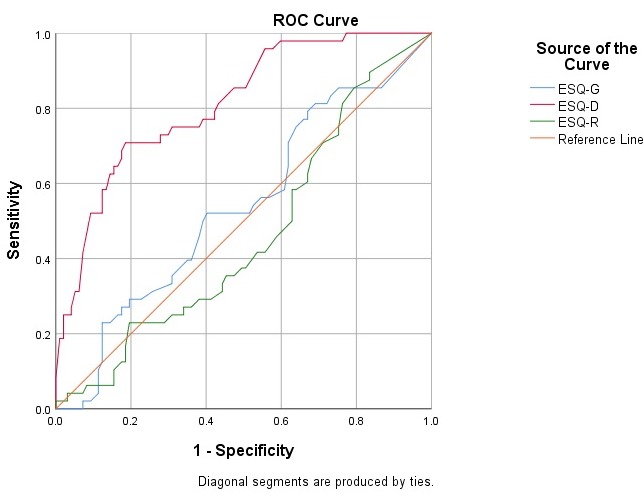Monday Poster Session
Category: Esophagus
P1858 - The Esophageal Symptom Questionnaire (ESQ-30) May Differentiate Achalasia from EGJ Outflow Obstruction
Monday, October 23, 2023
10:30 AM - 4:15 PM PT
Location: Exhibit Hall

Has Audio

Dain Kim, MSc
University of Saskatchewan
Saskatoon, SK, Canada
Presenting Author(s)
Dain Kim, MSc1, Prateek Kundapur, MD2, Christopher N. Andrews, MD2, Milli Gupta, MD2, Matthew Woo, MD2
1University of Saskatchewan, Saskatoon, SK, Canada; 2University of Calgary, Calgary, AB, Canada
Introduction: The manometric diagnoses of achalasia and esophagogastric junction outflow obstruction (EGJOO) are difficult to differentiate based solely on symptoms. The Esophageal Symptom Questionnaire (ESQ-30) is a standardized outcome measure of the frequency and severity esophageal symptoms and contains the following subscales: globus (ESQ-G), dysphagia (ESQ-D), and reflux symptoms (ESQ-R). Our study aims to elucidate the association between manometric diagnosis and symptoms using the ESQ-30.
Methods: Between October 2021 - March 2023, 681 patients (54.5 +/- 14.8 y, 65% female) underwent esophageal manometry and had complete ESQ-30 questionnaires: 379 normal, 109 ineffective esophageal motility, 14 jackhammer esophagus, 20 absent contractility, 14 distal esophageal spasm, 97 EGJOO, 48 achalasia (3 achalasia type 1, 41 achalasia type 2, 4 achalasia type 3). A one-way ANOVA was performed to compare the effect of manometric diagnosis on ESQ-D, ESQ-G and ESQ-R scores. Receiver operating characteristic (ROC) analysis was performed.
Results: The one-way ANOVA comparing the effect of manometric diagnosis on ESQ-D, globus ESQ-G and reflux ESQ-R scores showed that there was a statistically significant difference between at least two groups in globus (F (8,672) = 2.4, p = .015) and dysphagia (F (8,672) = 15.2, p< .01). Bonferroni test for multiple comparisons found that the mean value of ESQ-D was significantly higher in jackhammer esophagus compared to normal motility (mean difference 19.7, p=.03, 95%CI 1.1-38.2). The mean value of the ESQ-D was significantly higher in type 2 achalasia compared to normal (mean difference 33.3, p< .01, 95%CI 22.2-44.5), ineffective esophageal motility (mean difference 31.3, p< .01 95%CI 18.8-43.7), and EGJOO (mean difference 29.3, p< .01, 95%CI 16.6-42.0). The ESQ-D differentiated between patients with achalasia and EGJOO with an AUC of .812 (.74-.88).
Discussion: This study compared the ESQ-30 scores for dysphagia, globus, and reflux between patients with different esophageal motility disorders including achalasia and EGJOO. The mean dysphagia impact score (ESQ-D) was significantly different when comparing the achalasia group with both the EGJOO and the normal groups. Differentiating achalasia from non-achalasia EGJOO is of key importance as achalasia has definitive therapy, while the clinical significance of non-achalasia EGJOO is less certain. Our findings suggest that standardized patient symptom scores may play a role in discriminating between these two conditions.

Disclosures:
Dain Kim, MSc1, Prateek Kundapur, MD2, Christopher N. Andrews, MD2, Milli Gupta, MD2, Matthew Woo, MD2. P1858 - The Esophageal Symptom Questionnaire (ESQ-30) May Differentiate Achalasia from EGJ Outflow Obstruction, ACG 2023 Annual Scientific Meeting Abstracts. Vancouver, BC, Canada: American College of Gastroenterology.
1University of Saskatchewan, Saskatoon, SK, Canada; 2University of Calgary, Calgary, AB, Canada
Introduction: The manometric diagnoses of achalasia and esophagogastric junction outflow obstruction (EGJOO) are difficult to differentiate based solely on symptoms. The Esophageal Symptom Questionnaire (ESQ-30) is a standardized outcome measure of the frequency and severity esophageal symptoms and contains the following subscales: globus (ESQ-G), dysphagia (ESQ-D), and reflux symptoms (ESQ-R). Our study aims to elucidate the association between manometric diagnosis and symptoms using the ESQ-30.
Methods: Between October 2021 - March 2023, 681 patients (54.5 +/- 14.8 y, 65% female) underwent esophageal manometry and had complete ESQ-30 questionnaires: 379 normal, 109 ineffective esophageal motility, 14 jackhammer esophagus, 20 absent contractility, 14 distal esophageal spasm, 97 EGJOO, 48 achalasia (3 achalasia type 1, 41 achalasia type 2, 4 achalasia type 3). A one-way ANOVA was performed to compare the effect of manometric diagnosis on ESQ-D, ESQ-G and ESQ-R scores. Receiver operating characteristic (ROC) analysis was performed.
Results: The one-way ANOVA comparing the effect of manometric diagnosis on ESQ-D, globus ESQ-G and reflux ESQ-R scores showed that there was a statistically significant difference between at least two groups in globus (F (8,672) = 2.4, p = .015) and dysphagia (F (8,672) = 15.2, p< .01). Bonferroni test for multiple comparisons found that the mean value of ESQ-D was significantly higher in jackhammer esophagus compared to normal motility (mean difference 19.7, p=.03, 95%CI 1.1-38.2). The mean value of the ESQ-D was significantly higher in type 2 achalasia compared to normal (mean difference 33.3, p< .01, 95%CI 22.2-44.5), ineffective esophageal motility (mean difference 31.3, p< .01 95%CI 18.8-43.7), and EGJOO (mean difference 29.3, p< .01, 95%CI 16.6-42.0). The ESQ-D differentiated between patients with achalasia and EGJOO with an AUC of .812 (.74-.88).
Discussion: This study compared the ESQ-30 scores for dysphagia, globus, and reflux between patients with different esophageal motility disorders including achalasia and EGJOO. The mean dysphagia impact score (ESQ-D) was significantly different when comparing the achalasia group with both the EGJOO and the normal groups. Differentiating achalasia from non-achalasia EGJOO is of key importance as achalasia has definitive therapy, while the clinical significance of non-achalasia EGJOO is less certain. Our findings suggest that standardized patient symptom scores may play a role in discriminating between these two conditions.

Figure: Receiver Operator Curve Analysis for ESQ-G, ESQ-D, ESQ-R
Disclosures:
Dain Kim indicated no relevant financial relationships.
Prateek Kundapur indicated no relevant financial relationships.
Christopher Andrews: Alimetry Ltd. – Employee.
Milli Gupta indicated no relevant financial relationships.
Matthew Woo indicated no relevant financial relationships.
Dain Kim, MSc1, Prateek Kundapur, MD2, Christopher N. Andrews, MD2, Milli Gupta, MD2, Matthew Woo, MD2. P1858 - The Esophageal Symptom Questionnaire (ESQ-30) May Differentiate Achalasia from EGJ Outflow Obstruction, ACG 2023 Annual Scientific Meeting Abstracts. Vancouver, BC, Canada: American College of Gastroenterology.
